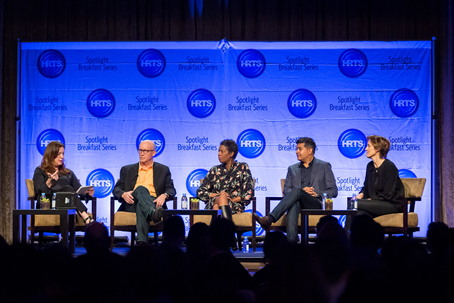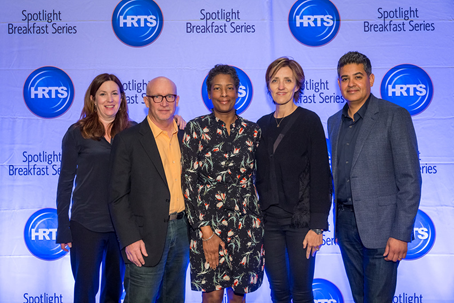Enough attention has been paid to the massive scripted programming boon over the past decade. But scripted isn’t the only programming sector doing gangbuster business lately.
Thanks to the rise of reality TV, the fall of hard news, and a fresh wave of filmmakers experimenting with the form, documentaries have demanded a growing piece of the television marketplace.
On Wednesday, the Hollywood Radio & TV Society spotlighted the booming genre with a panel of luminaries in the field, entitled “Who’s Buying and Watching Documentary on TV.”
Molly Thompson, senior VP, feature films, A+E Networks and founder of A&E IndieFilms moderated the discussion and began with some illuminating statistics on TV documentary’s evolution.
From 2012 to 2017, there’s been a 75 percent increase in hours devoted to documentaries on cable, while hours of premium cable documentary programming has more than doubled in that time. Today, 30 networks are producing original documentaries of some kind, a figure that doesn’t include SVOD platforms.
Oscar and Emmy-winning filmmaker Alex Gibney credited the reality TV boom with opening the door.
“Reality TV actually changed people’s minds,” said Gibney. “Suddenly they could watch stuff without actors and be entertained.”
Documentary filmmaker luminaries like Steve James (Hoop Dreams), Errol Morris (Wormwood) and Barbara Kopple (Harlan County U.S.A.) helped keep the door open for a new glut of experimental filmmakers who threw out the turgid rules of old.
“We could tell stories they do in fiction but with real people, which is unpredictable, engaging,” said Gibney. “It made docs more interesting to watch even than fiction films, which had become formulaic.”
Gibney highlighted ESPN’s 30 for 30 docuseries as a major breakthrough for the industry.

“It said to people you could brand a series around well-curated stories, but each story is going to have a director’s voice like a nonfiction book,” said Gibney.
Another factor in the growing demand for documentaries was the paralleled decline in resources spent on hard news.
Dawn Porter, director and producer, and Vinnie Malhotra, senior VP, documentaries, unscripted and sports programming, Showtime Networks Inc., witnessed this phenomenon firsthand while working for ABC News.
Networks switched their focus from evening news to morning news as Peter Jennings, Dan Rather, Tom Brokaw and Ted Koppel retired. Malhotra noticed the big shift during the Iraq war.
“An entire war was taking place, and there was no coverage of it,” he said. “Yet if you looked across at documentary filmmaking, you were getting a real sense and depth of what that war, that experience was like.”
Another turning point was the Pat Tillman story, one that Malhotra thought he had told at ABC. But when The Tillman Story was released in 2010 (produced by Thompson), Malhotra and the rest of the country that was paying attention saw otherwise.
“We had missed the entire story,” he said. “Documentarians spend more time in a story, dig deeper, and find truth in a way that a 24-hour news cycle can’t. Now you cover a school shooting for two days and move on.”
And sure enough, audiences tuned in for the truth.
“Taxi drivers were talking about Enron. That had never happened before,” said Gibney. “It wasn’t a cloistered few watching in a small room somewhere. It became a popular form. There was a hunger for stories going after abuses of power. As governments wither and corporations rise, there’s a sense that misdeeds aren’t being held to account.”
Unsurprisingly, networks noticed.
“When I was first coming up, cable channels were so branded, whatever you were going to do, you had to do the doc the branded way according to that network,” said Gibney. “Back when there were clickers, you had to get a sense of what the channel was when clicking through. It became very constricting and made for very dull storytelling.”
As the clicker went bye-bye, the relationship changed.
“There was a power shift from channel’s brands to filmmakers and the audience because of social media and the very sophisticated, mature nature of the platforms we all use,” said Liesl Copland, partner, Endeavor Content.
Endeavor Content’s non-fiction division is headed by Copland and is focused on finding financiers and bridging partnerships to find homes for documentaries.
“We don’t have a network, we’re not competing. Our goal is to work in this exciting system with any creator anywhere and give them resources, to help give the depth the audience expects.”
The growing success of documentary filmmaking has led to conflicts in the marketplace when documentarians are going after the same story as a studio looking to adapt a fictional take.
“There never would be any conflict, because I was just doing a little documentary,” said Gibney. “Now it’s seen as direct competition. There’s arm wrestling behind the scenes to prevent documentaries from being produced because there’s a fear that one will eclipse the other.”
Malhotra believes multiple stories can coexist, pointing to the two concurrent O.J. Simpson projects in 2016 – FX’s The People v. O.J. Simpson and ESPN’s O.J.: Made in America – “neither of which suffered from the existence of the other.”
“But there is a tension now,” said Gibney. “Some places want to crush a project so it owns the story entirely. We’re rubbing against big players in ways we didn’t use to before.”
That, coupled with higher demand, has led to bigger budgets for docuseries.
“This is great creatively,” said Porter. “You’re using better cameras, you get to have more researchers, more travel, more time. That’s what the audience is responding to.”
As Thompson pointed out, documentaries used to be less risky for studios and networks precisely because of their low budgets. Now that’s no longer the case.

Regardless, the panelists are all bullish about the future of documentary on TV.
“It’s here to stay. With theatricals shifting to home viewing, it’s out of the closet now,” said Copland. “The audience wants these stories and channels are going to stick with it.”
Plus, the space is only growing with Disney and Apple’s forthcoming platforms promising even more nonfiction programming.
“There’s a blurring of lines at networks,” said Malhotra. “Networks are incorporating documentaries within the programming structure of their scripted series and everything else to create one voice. It’s not two separate strands. Having them weave their storytelling closer together makes it more here to stay. It flows much better within their overall programming.”
“You want to partner with a network that shares your vision with the project. It isn’t always the case and it’s just as important in many cases as the filmmaker’s own passion for the project,” said Gibney. “So many networks seem to be engaged in this that it makes me encouraged and enthusiastic for the future.”
An avenue for improvement within documentary programming is in the marketing – to better harness social media and ancillary content.
“It’s an underserved idea that hasn’t been properly worked out,” said Gibney. “Everyone agrees there should be a website for a film, but don’t think about taking it further, like putting out material that never got into the film, or reaching out to communities of interest to drive interest in that film. Many have tried to come up with a model, but nobody’s done it that I can think of.”
Copland complimented Netflix’s nontraditional marketing efforts for Jim & Andy – a documentary chronicling Jim Carrey’s transformative turn playing Andy Kaufman in Man on the Moon.
“Everything’s marketing,” said Copland. “You have to break through that noise.”
“With our industry being more crowded, it’s how can you be more creative, be more aggressive,” said Malhotra.
Case in point: Showtime has begun experimenting with releasing documentaries in front of the paywall to draw people to the story, and by extension, the brand.
Given increasing budgets for documentary programming, Copland believes that will naturally lead to a higher percentage in assets spent on marketing, which should help the cause.
As documentaries become more popular and in-demand, Porter warns against possible side effects.
“Now it’s becoming, ‘when are you going to be done? You have to be done in a year and be at a big festival,’” she said. “As we mature budget-wise and with how popular these are, we’re going to have to push back on that. We can’t grind it out, or else we lose what makes the film special.”
For now, at least, it’s a special time for documentaries on television.
[Images courtesy of Netflix, ESPN, HRTS]
Tags: alex gibney hrts













































__twocolumncontent.jpg)











